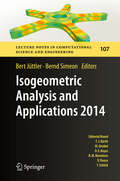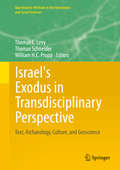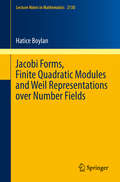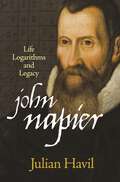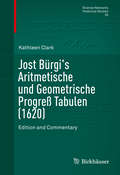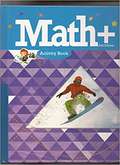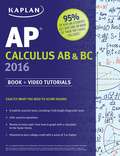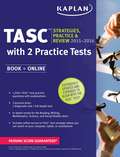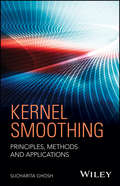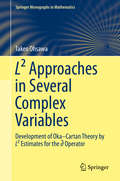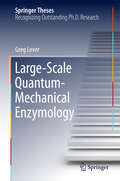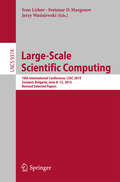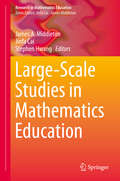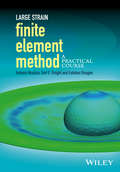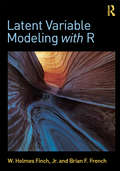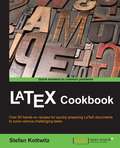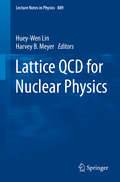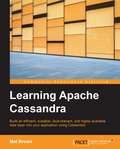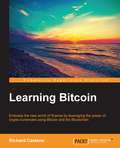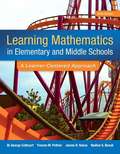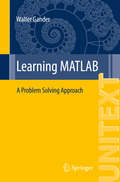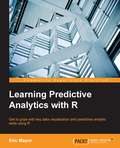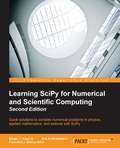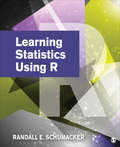- Table View
- List View
Isogeometric Analysis and Applications 2014
by Bert Jüttler Bernd SimeonIsogeometric Analysis is a groundbreaking computational approach that promises the possibility of integrating the finite element method into conventional spline-based CAD design tools. It thus bridges the gap between numerical analysis and geometry, and moreover it allows to tackle new cutting edge applications at the frontiers of research in science and engineering. This proceedings volume contains a selection of outstanding research papers presented at the second International Workshop on Isogeometric Analysis and Applications, held at Annweiler, Germany, in April 2014.
Isolated Singularities in Partial Differential Inequalities
by Marius Ghergu Steven D. TaliaferroIn this monograph, the authors present some powerful methods for dealing with singularities in elliptic and parabolic partial differential inequalities. Here, the authors take the unique approach of investigating differential inequalities rather than equations, the reason being that the simplest way to study an equation is often to study a corresponding inequality; for example, using sub and superharmonic functions to study harmonic functions. Another unusual feature of the present book is that it is based on integral representation formulae and nonlinear potentials, which have not been widely investigated so far. This approach can also be used to tackle higher order differential equations. The book will appeal to graduate students interested in analysis, researchers in pure and applied mathematics, and engineers who work with partial differential equations. Readers will require only a basic knowledge of functional analysis, measure theory and Sobolev spaces.
Israel's Exodus in Transdisciplinary Perspective
by Thomas E. Levy Thomas Schneider William H.C. ProppThe Bible's grand narrative about Israel's Exodus from Egypt is central to Biblical religion, Jewish, Christian, and Muslim identity and the formation of the academic disciplines studying the ancient Near East. It has also been a pervasive theme in artistic and popular imagination Israel's Exodus in Transdisciplinary Perspective is a pioneering work surveying this tradition in unprecedented breadth, combining archaeological discovery, quantitative methodology and close literary reading. Archaeologists, Egyptologists, Biblical Scholars, Computer Scientists, Geoscientists and other experts contribute their diverse approaches in a novel, transdisciplinary consideration of ancient topography, Egyptian and Near Eastern parallels to the Exodus story, the historicity of the Exodus, the interface of the Exodus question with archaeological fieldwork on emergent Israel, the formation of biblical literature, and the cultural memory of the Exodus in ancient Israel and beyond. This edited volume contains research presented at the groundbreaking symposium "Out of Egypt: Israel's Exodus Between Text and Memory, History and Imagination" held in 2013 at the Qualcomm Institute of the University of California, San Diego. The combination of 44 contributions by an international group of scholars from diverse disciplines makes this the first such transdisciplinary study of ancient text and history. In the original conference and with this new volume, revolutionary media, such as a 3D immersive virtual reality environment, impart innovative, Exodus-based research to a wider audience. Out of archaeology, ancient texts, science and technology emerge an up-to-date picture of the Exodus for the 21st Century and a new standard for collaborative research.
Jacobi Forms, Finite Quadratic Modules and Weil Representations over Number Fields
by Hatice BoylanThe new theory of Jacobi forms over totally real number fields introduced in this monograph is expected to give further insight into the arithmetic theory of Hilbert modular forms, its L-series, and into elliptic curves over number fields. This work is inspired by the classical theory of Jacobi forms over the rational numbers, which is an indispensable tool in the arithmetic theory of elliptic modular forms, elliptic curves, and in many other disciplines in mathematics and physics. Jacobi forms can be viewed as vector valued modular forms which take values in so-called Weil representations. Accordingly, the first two chapters develop the theory of finite quadratic modules and associated Weil representations over number fields. This part might also be interesting for those who are merely interested in the representation theory of Hilbert modular groups. One of the main applications is the complete classification of Jacobi forms of singular weight over an arbitrary totally real number field.
John Napier: Life, Logarithms, and Legacy
by Julian HavilThe most comprehensive account of the mathematician's life and workJohn Napier (1550–1617) is celebrated today as the man who invented logarithms—an enormous intellectual achievement that would soon lead to the development of their mechanical equivalent in the slide rule: the two would serve humanity as the principal means of calculation until the mid-1970s. Yet, despite Napier's pioneering efforts, his life and work have not attracted detailed modern scrutiny. John Napier is the first contemporary biography to take an in-depth look at the multiple facets of Napier’s story: his privileged position as the eighth Laird of Merchiston and the son of influential Scottish landowners; his reputation as a magician who dabbled in alchemy; his interest in agriculture; his involvement with a notorious outlaw; his staunch anti-Catholic beliefs; his interactions with such peers as Henry Briggs, Johannes Kepler, and Tycho Brahe; and, most notably, his estimable mathematical legacy.Julian Havil explores Napier’s original development of logarithms, the motivations for his approach, and the reasons behind certain adjustments to them. Napier’s inventive mathematical ideas also include formulas for solving spherical triangles, "Napier’s Bones" (a more basic but extremely popular alternative device for calculation), and the use of decimal notation for fractions and binary arithmetic. Havil also considers Napier’s study of the Book of Revelation, which led to his prediction of the Apocalypse in his first book, A Plaine Discovery of the Whole Revelation of St. John—the work for which Napier believed he would be most remembered.John Napier assesses one man’s life and the lasting influence of his advancements on the mathematical sciences and beyond.
Jost Bürgi's Aritmetische und Geometrische Progreß Tabulen
by Kathleen ClarkThis monograph presents a groundbreaking scholarly treatment of the German mathematician Jost Bürgi's original work on logarithms, Arithmetische und Geometrische Progreß Tabulen. It provides the first-ever English translation of Bürgi's text and illuminates his role in the development of the conception of logarithms, for which John Napier is traditionally given priority. High-resolution scans of each page of the his handwritten text are reproduced for the reader and as a means of preserving an important work for which there are very few surviving copies. The book begins with a brief biography of Bürgi to familiarize readers with his life and work, as well as to offer an historical context in which to explore his contributions. The second chapter then describes the extant copies of the Arithmetische und Geometrische Progreß Tabulen, with a detailed description of the copy that is the focus of this book, the 1620 "Graz manuscript". A complete facsimile of the text is included in the next chapter, along with a corresponding transcription and an English translation; a transcription of a second version of the manuscript (the "Gdansk manuscript") is included alongside that of the Graz edition so that readers can easily and closely examine the differences between the two. The final chapter considers two important questions about Bürgi's work, such as who was the copyist of the Graz manuscript and what the relationship is between the Graz and Gdansk versions. Appendices are also included that contain a timeline of Bürgi's life, the underlying concept of Napier's construction of logarithms, and scans of all 58 sheets of the tables from Bürgi's text. Anyone with an appreciation for the history of mathematics will find this book to be an insightful and interesting look at an important and often overlooked work. It will also be a valuable resource for undergraduates taking courses in the history of mathematics, researchers of the history of mathematics, and professors of mathematics education who wish to incorporate historical context into their teaching.
Kaplan AP Calculus AB & BC 2016
by Tamara Lefcourt Ruby James Sellers Lisa Korf Jeremy Van Horn Mike MunnThe only Advanced Placement test preparation guide that delivers 75 years of proven Kaplan experience and features exclusive strategies, practice, and review to help students ace the AP Calculus AB & BC exam! Students spend the school year preparing for the AP Calculus AB & BC test. Now it's time to reap the rewards: money-saving college credit, advanced placement, or an admissions edge. However, achieving a top score on the AP Calculus AB & BC exam requires more than knowing the material--students need to get comfortable with the test format itself, prepare for pitfalls, and arm themselves with foolproof strategies. That's where the Kaplan plan has the clear advantage. Kaplan's AP Calculus AB & BC 2016 offers many essential and unique features to help improve test scores, including: * Eight full-length practice tests, including two diagnostic tests to target areas for score improvement * Detailed answer explanations * Expert video tutorials * Tips and strategies for scoring higher from expert AP Calculus AB & BC teachers and students who got a perfect 5 on the exam * Targeted review of the most up-to-date content, including any information about test changes and key information that is specific to the AP Calculus AB & BC exam Kaplan's AP Calculus AB & BC 2016 authors Tamara Lefcourt Ruby, James Sellers, Lisa Korf, Jeremy Van Horn, and Mike Munn have many years of experience teaching calculus as well as other math courses. Their expertise has helped make this and other books the best that Kaplan has to offer in AP test prep. Kaplan's AP Calculus AB & BC 2016 provides students with everything they need to improve their scores--guaranteed. Kaplan's Higher Score guarantee provides security that no other test preparation guide on the market can match. Kaplan has helped more than three million students to prepare for standardized tests. We invest more than $4.5 million annually in research and support for our products. We know that our test-taking techniques and strategies work and our materials are completely up-to-date. Kaplan's AP Calculus AB & BC 2016 is the must-have preparation tool for every student looking to do better on the AP Calculus AB & BC test!
Kaplan TASC Strategies, Practice, and Review 2015-2016
by KaplanComprehensive content review, strategies, and practice for all sections of the TASC (Test Assessing Secondary Completion) from top test experts.
Kernel Smoothing: Principles, Methods and Applications
by Sucharita GhoshComprehensive theoretical overview of kernel smoothing methods with motivating examples Kernel smoothing is a flexible nonparametric curve estimation method that is applicable when parametric descriptions of the data are not sufficiently adequate. This book explores theory and methods of kernel smoothing in a variety of contexts, considering independent and correlated data e.g. with short-memory and long-memory correlations, as well as non-Gaussian data that are transformations of latent Gaussian processes. These types of data occur in many fields of research, e.g. the natural and the environmental sciences, and others. Nonparametric density estimation, nonparametric and semiparametric regression, trend and surface estimation in particular for time series and spatial data and other topics such as rapid change points, robustness etc. are introduced alongside a study of their theoretical properties and optimality issues, such as consistency and bandwidth selection. Addressing a variety of topics, Kernel Smoothing: Principles, Methods and Applications offers a user-friendly presentation of the mathematical content so that the reader can directly implement the formulas using any appropriate software. The overall aim of the book is to describe the methods and their theoretical backgrounds, while maintaining an analytically simple approach and including motivating examples—making it extremely useful in many sciences such as geophysics, climate research, forestry, ecology, and other natural and life sciences, as well as in finance, sociology, and engineering. A simple and analytical description of kernel smoothing methods in various contexts Presents the basics as well as new developments Includes simulated and real data examples Kernel Smoothing: Principles, Methods and Applications is a textbook for senior undergraduate and graduate students in statistics, as well as a reference book for applied statisticians and advanced researchers.
L² Approaches in Several Complex Variables
by Takeo OhsawaThe purpose of this monograph is to present the current status of a rapidly developing part of several complex variables, motivated by the applicability of effective results to algebraic geometry and differential geometry. Highlighted are the new precise results on the L² extension of holomorphic functions. In Chapter 1, the classical questions of several complex variables motivating the development of this field are reviewed after necessary preparations from the basic notions of those variables and of complex manifolds such as holomorphic functions, pseudoconvexity, differential forms, and cohomology. In Chapter 2, the L² method of solving the d-bar equation is presented emphasizing its differential geometric aspect. In Chapter 3, a refinement of the Oka-Cartan theory is given by this method. The L² extension theorem with an optimal constant is included, obtained recently by Z. BÅ,ocki and by Q. -A. Guan and X. -Y. Zhou separately. In Chapter 4, various results on the Bergman kernel are presented, including recent works of Maitani-Yamaguchi, Berndtsson, and Guan-Zhou. Most of these results are obtained by the L² method. In the last chapter, rather specific results are discussed on the existence and classification of certain holomorphic foliations and Levi flat hypersurfaces as their stables sets. These are also applications of the L² method obtained during these 15 years.
Large-Scale Quantum-Mechanical Enzymology
by Greg LeverThis work establishes linear-scaling density-functional theory (DFT) as a powerful tool for understanding enzyme catalysis, one that can complement quantum mechanics/molecular mechanics (QM/MM) and molecular dynamics simulations. The thesis reviews benchmark studies demonstrating techniques capable of simulating entire enzymes at the ab initio quantum-mechanical level of accuracy. DFT has transformed the physical sciences by allowing researchers to perform parameter-free quantum-mechanical calculations to predict a broad range of physical and chemical properties of materials. In principle, similar methods could be applied to biological problems. However, even the simplest biological systems contain many thousands of atoms and are characterized by extremely complex configuration spaces associated with a vast number of degrees of freedom. The development of linear-scaling density-functional codes makes biological molecules accessible to quantum-mechanical calculation, but has yet to resolve the complexity of the phase space. Furthermore, these calculations on systems containing up to 2,000 atoms can capture contributions to the energy that are not accounted for in QM/MM methods (for which the Nobel prize in Chemistry was awarded in 2013) and the results presented here reveal profound shortcomings in said methods.
Large-Scale Scientific Computing
by Ivan Lirkov Svetozar D. Margenov Jerzy WaśniewskiThis book constitutes the thoroughly refereedpost-conference proceedings of the 10th International Conference on Large-ScaleScientific Computations, LSSC 2015, held in Sozopol, Bulgaria, in June 2015. The 49 revised full papers presented were carefullyreviewed and selected from 64 submissions. The general theme for LSSC 2015 wasLarge-Scale Scientific Computing with a particular focus on the organizedspecial sessions: enabling exascale computation; control and uncertain systems;computational microelectronics - from monte carlo to deterministic approaches;numerical methods for multiphysics problems; large-scale models: numericalmethods, parallel computations and applications; mathematical modeling andanalysis of PDEs describing physical problems; a posteriori error control anditerative methods for maxwell type problems; efficient algorithms for hybridHPC systems; multilevel methods on graphs; and applications of metaheuristicsto large-scale problems.
Large-Scale Studies in Mathematics Education
by James A. Middleton Jinfa Cai Stephen HwangIn recent years, funding agencies like the Institute of Educational Sciences and the National Science Foundation have increasingly emphasized large-scale studies with experimental and quasi-experimental designs looking for 'objective truths' Educational researchers have recently begun to use large-scale studies to understand what really works, from developing interventions, to validation studies of the intervention, and then to efficacy studies and the final "scale-up" for large implementation of an intervention. Moreover, modeling student learning developmentally, taking into account cohort factors, issues of socioeconomics, local political context and the presence or absence of interventions requires the use of large data sets, wherein these variables can be sampled adequately and inferences made Inroads in quantitative methods have been made in the psychometric and sociometric literatures, but these methods are not yet common knowledge in the mathematics education community. In fact, currently there is no volume devoted to discussion of issues related to large-scale studies and to report findings from them This volume is unique as it directly discusses methodological issue in large-scale studies and reports empirical data from large-scale studies.
Large Strain Finite Element Method
by Earl E. Knight Esteban Rougier Antonio MunjizaAn introductory approach to the subject of large strains and large displacements in finite elements.Large Strain Finite Element Method: A Practical Course, takes an introductory approach to the subject of large strains and large displacements in finite elements and starts from the basic concepts of finite strain deformability, including finite rotations and finite displacements. The necessary elements of vector analysis and tensorial calculus on the lines of modern understanding of the concept of tensor will also be introduced.This book explains how tensors and vectors can be described using matrices and also introduces different stress and strain tensors. Building on these, step by step finite element techniques for both hyper and hypo-elastic approach will be considered.Material models including isotropic, unisotropic, plastic and viscoplastic materials will be independently discussed to facilitate clarity and ease of learning. Elements of transient dynamics will also be covered and key explicit and iterative solvers including the direct numerical integration, relaxation techniques and conjugate gradient method will also be explored.This book contains a large number of easy to follow illustrations, examples and source code details that facilitate both reading and understanding. Takes an introductory approach to the subject of large strains and large displacements in finite elements. No prior knowledge of the subject is required.Discusses computational methods and algorithms to tackle large strains and teaches the basic knowledge required to be able to critically gauge the results of computational models.Contains a large number of easy to follow illustrations, examples and source code details.Accompanied by a website hosting code examples.
Latent Variable Modeling with R
by W. Holmes Finch Brian F. FrenchThis book demonstrates how to conduct latent variable modeling (LVM) in R by highlighting the features of each model, their specialized uses, examples, sample code and output, and an interpretation of the results. Each chapter features a detailed example including the analysis of the data using R, the relevant theory, the assumptions underlying the model, and other statistical details to help readers better understand the models and interpret the results. Every R command necessary for conducting the analyses is described along with the resulting output which provides readers with a template to follow when they apply the methods to their own data. The basic information pertinent to each model, the newest developments in these areas, and the relevant R code to use them are reviewed. Each chapter also features an introduction, summary, and suggested readings. A glossary of the text’s boldfaced key terms and key R commands serve as helpful resources. The book is accompanied by a website with exercises, an answer key, and the in-text example data sets. Latent Variable Modeling with R: -Provides some examples that use messy data providing a more realistic situation readers will encounter with their own data. -Reviews a wide range of LVMs including factor analysis, structural equation modeling, item response theory, and mixture models and advanced topics such as fitting nonlinear structural equation models, nonparametric item response theory models, and mixture regression models. -Demonstrates how data simulation can help researchers better understand statistical methods and assist in selecting the necessary sample size prior to collecting data. -www.routledge.com/9780415832458 provides exercises that apply the models along with annotated R output answer keys and the data that corresponds to the in-text examples so readers can replicate the results and check their work. The book opens with basic instructions in how to use R to read data, download functions, and conduct basic analyses. From there, each chapter is dedicated to a different latent variable model including exploratory and confirmatory factor analysis (CFA), structural equation modeling (SEM), multiple groups CFA/SEM, least squares estimation, growth curve models, mixture models, item response theory (both dichotomous and polytomous items), differential item functioning (DIF), and correspondance analysis. ?The book concludes with a discussion of how data simulation can be used to better understand the workings of a statistical method and assist researchers in deciding on the necessary sample size prior to collecting data.? A mixture of independently developed R code along with available libraries for simulating latent models in R are provided so readers can use these simulations to analyze data using the methods introduced in the previous chapters. Intended for use in graduate or advanced undergraduate courses in latent variable modeling, factor analysis, structural equation modeling, item response theory, measurement, or multivariate statistics taught in psychology, education, human development, and social and health sciences, researchers in these fields also appreciate this book’s practical approach. The book provides sufficient conceptual background information to serve as a standalone text.? Familiarity with basic statistical concepts is assumed but basic knowledge of R is not.
LaTeX Cookbook
by Stefan KottwitzOver 100 hands-on recipes to quickly prepare LaTeX documents of various kinds to solve challenging tasksAbout This BookWork with modern document classes, such as KOMA-Script classesExplore the latest LaTeX packages, including TikZ, pgfplots, and biblatexAn example-driven approach to creating stunning graphics directly within LaTeXWho This Book Is ForIf you already know the basics of LaTeX and you like to get fast, efficient solutions, this is the perfect book for you. If you are an advanced reader, you can use this book's example-driven format to take your skillset to the next level. Some familiarity with the basic syntax of LaTeX and how to use the editor of your choice for compiling is required.What You Will LearnChoose the right document class for your project to customize its featuresUtilize fonts globally and locallyFrame, shape, arrange, and annotate imagesAdd a bibliography, a glossary, and an indexCreate colorful graphics including diagrams, flow charts, bar charts, trees, plots in 2d and 3d, time lines, and mindmapsSolve typical tasks for various sciences including math, physics, chemistry, electrotechnics, and computer scienceOptimize PDF output and enrich it with meta data, annotations, popups, animations, and fill-in fieldsExplore the outstanding capabilities of the newest engines and formats such as XeLaTeX, LuaLaTeX, and LaTeX3In DetailLaTeX is a high-quality typesetting software and is very popular, especially among scientists. Its programming language gives you full control over every aspect of your documents, no matter how complex they are. LaTeX's huge amount of customizable templates and supporting packages cover most aspects of writing with embedded typographic expertise.With this book you will learn to leverage the capabilities of the latest document classes and explore the functionalities of the newest packages.The book starts with examples of common document types. It provides you with samples for tuning text design, using fonts, embedding images, and creating legible tables. Common document parts such as the bibliography, glossary, and index are covered, with LaTeX's modern approach.You will learn how to create excellent graphics directly within LaTeX, including diagrams and plots quickly and easily.Finally, you will discover how to use the new engines XeTeX and LuaTeX for advanced programming and calculating with LaTeX.The example-driven approach of this book is sure to increase your productivity.Style and approachThis book guides you through the world of LaTeX based on over a hundred hands-on examples. These are explained in detail and are designed to take minimal time and to be self-compliant.
Lattice QCD for Nuclear Physics
by Huey-Wen Lin Harvey B. MeyerWith ever increasing computational resources and improvements in algorithms, new opportunities are emerging for lattice gauge theory to address key questions in strongly interacting systems, such as nuclear matter. Calculations today use dynamical gauge-field ensembles with degenerate light up/down quarks and the strange quark and it is possible now to consider including charm-quark degrees of freedom in the QCD vacuum. Pion masses and other sources of systematic error, such as finite-volume and discretization effects, are beginning to be quantified systematically. Altogether, an era of precision calculation has begun and many new observables will be calculated at the new computational facilities. The aim of this set of lectures is to provide graduate students with a grounding in the application of lattice gauge theory methods to strongly interacting systems and in particular to nuclear physics. A wide variety of topics are covered, including continuum field theory, lattice discretizations, hadron spectroscopy and structure, many-body systems, together with more topical lectures in nuclear physics aimed a providing a broad phenomenological background. Exercises to encourage hands-on experience with parallel computing and data analysis are included.
Learning Apache Cassandra
by Mat BrownIf you're an application developer familiar with SQL databases such as MySQL or Postgres, and you want to explore distributed databases such as Cassandra, this is the perfect guide for you. Even if you've never worked with a distributed database before, Cassandra's intuitive programming interface coupled with the step-by-step examples in this book will have you building highly scalable persistence layers for your applications in no time.
Learning Bitcoin
by Richard CaetanoEmbrace the new world of fiance by leveraging the power of crypto-currencies using Bitcoin and the BlockchainAbout This BookSet up your own wallet, buy and sell Bitcoin, and execute custom transactions on the BlockchainLeverage the power of Bitcoin to reduce transaction costs and eliminate fraudA practical step-by-step guide to break down the Bitcoin technology to ensure safe transactionsWho This Book Is ForIf you are familiar with online banking and want to expand your finances into a resilient and transparent currency, this book is ideal for you. A basic understanding of online wallets and financial systems will be highly beneficial to unravel the mysteries of Bitcoin.What You Will LearnSet up your wallet and buy a Bitcoin in a flash while understanding the basics of addresses and transactionsAcquire the knack of buying, selling, and trading Bitcoins with online marketplacesSecure and protect your Bitcoins from online theft using Brainwallets and cold storageUnderstand how Bitcoin's underlying technology, the Blockchain, works with simple illustrations and explanationsConfigure your own Bitcoin node and execute common operations on the networkDiscover various aspects of mining Bitcoin and how to set up your own mining rigDive deeper into Bitcoin and write scripts and multi-signature transactions on the networkExplore the various alt-coins and get to know how to compare them and their valueIn DetailThe financial crisis of 2008 raised attention to the need for transparency and accountability in the financial world. As banks and governments were scrambling to stay solvent while seeking a sustainable plan, a powerfully new and resilient technology emerged.Bitcoin, built on a fundamentally new technology called "The Blockchain," offered the promise of a new financial system where transactions are sent directly between two parties without the need for central control.Bitcoin exists as an open and transparent financial system without banks, governments, or corporate support. Simply put, Bitcoin is "programmable money" that has the potential to change the world on the same scale as the Internet itself.This book arms you with immense knowledge of Bitcoin and helps you implement the technology in your money matters, enabling secure transactions.We first walk through the fundamentals of Bitcoin, illustrate how the technology works, and exemplify how to interact with this powerful and new financial technology. You will learn how to set up your online Bitcoin wallet, indulge in buying and selling of bitcoins, and manage their storage. We then get to grips with the most powerful algorithm of all times: the Blockchain, and learn how crypto-currencies can reduce the risk of fraud for e-commerce merchants and consumers.With a solid base of Blockchain, you will write and execute your own custom transactions. Most importantly, you will be able to protect and secure your Bitcoin with the help of effective solutions provided in the book. Packed with plenty of screenshots, Learning Bitcoin is a simple and painless guide to working with Bitcoin.Style and approachThis is an easy-to-follow guide to working with Bitcoin and the Blockchain technology. This book is ideal for anyone who wants to learn the basics of Bitcoin and explore how to set up their own transactions.
Learning Mathematics in Elementary and Middle School: A Learner-Centered Approach
by George S. Cathcart Yvonne M. Pothier James H. Vance Nadine S. BezukThis popular text promotes a learner-centered approach to teaching elementary and middle school mathematics. It provides valuable research-based instructional strategies, resources, and activities to help teachers evaluate how children think mathematically and how to link that knowledge to developmentally appropriate teaching practice. With its strong focus on Common Core Standards and analyzing children’s work to meet the individual needs of students, the book helps ensure that all students and teachers can be successful with math. The new edition features integration of the Common Core State Standards throughout, new examples of children’s work, updated internet links, expanded videos of children and classrooms, expanded “In Practice” features, and updated research on mathematics teaching and learning.
Learning MATLAB
by Walter GanderThis comprehensive and stimulating introduction to Matlab, a computer language now widely used for technical computing, is based on an introductory course held at Qian Weichang College, Shanghai University, in the fall of 2014. Teaching and learning a substantial programming language aren't always straightforward tasks. Accordingly, this textbook is not meant to cover the whole range of this high-performance technical programming environment, but to motivate first- and second-year undergraduate students in mathematics and computer science to learn Matlab by studying representative problems, developing algorithms and programming them in Matlab. While several topics are taken from the field of scientific computing, the main emphasis is on programming. A wealth of examples are completely discussed and solved, allowing students to learn Matlab by doing: by solving problems, comparing approaches and assessing the proposed solutions.
Learning Predictive Analytics with R
by Eric MayorGet to grips with key data visualization and predictive analytic skills using R About This Book * Acquire predictive analytic skills using various tools of R * Make predictions about future events by discovering valuable information from data using R * Comprehensible guidelines that focus on predictive model design with real-world data Who This Book Is For If you are a statistician, chief information officer, data scientist, ML engineer, ML practitioner, quantitative analyst, and student of machine learning, this is the book for you. You should have basic knowledge of the use of R. Readers without previous experience of programming in R will also be able to use the tools in the book. What You Will Learn * Customize R by installing and loading new packages * Explore the structure of data using clustering algorithms * Turn unstructured text into ordered data, and acquire knowledge from the data * Classify your observations using Naïve Bayes, k-NN, and decision trees * Reduce the dimensionality of your data using principal component analysis * Discover association rules using Apriori * Understand how statistical distributions can help retrieve information from data using correlations, linear regression, and multilevel regression * Use PMML to deploy the models generated in R In Detail R is statistical software that is used for data analysis. There are two main types of learning from data: unsupervised learning, where the structure of data is extracted automatically; and supervised learning, where a labeled part of the data is used to learn the relationship or scores in a target attribute. As important information is often hidden in a lot of data, R helps to extract that information with its many standard and cutting-edge statistical functions. This book is packed with easy-to-follow guidelines that explain the workings of the many key data mining tools of R, which are used to discover knowledge from your data. You will learn how to perform key predictive analytics tasks using R, such as train and test predictive models for classification and regression tasks, score new data sets and so on. All chapters will guide you in acquiring the skills in a practical way. Most chapters also include a theoretical introduction that will sharpen your understanding of the subject matter and invite you to go further. The book familiarizes you with the most common data mining tools of R, such as k-means, hierarchical regression, linear regression, association rules, principal component analysis, multilevel modeling, k-NN, Naïve Bayes, decision trees, and text mining. It also provides a description of visualization techniques using the basic visualization tools of R as well as lattice for visualizing patterns in data organized in groups. This book is invaluable for anyone fascinated by the data mining opportunities offered by GNU R and its packages. Style and approach This is a practical book, which analyzes compelling data about life, health, and death with the help of tutorials. It offers you a useful way of interpreting the data that's specific to this book, but that can also be applied to any other data.
Learning SciPy for Numerical and Scientific Computing - Second Edition
by Erik A Christensen Sergio J. Rojas G.This book targets programmers and scientists who have basic Python knowledge and who are keen to perform scientific and numerical computations with SciPy.
Learning Statistics Using R
by Randall E. SchumackerProviding easy-to-use R script programs that teach descriptive statistics, graphing, and other statistical methods, Learning Statistics Using R shows readers how to run and utilize R, a free integrated statistical suite that has an extensive library of functions. Schumacker’s comprehensive book describes the processing of variables in statistical procedures. Covering a wide range of topics, from probability and sampling distribution to statistical theorems and chi-square, this introductory book helps readers learn not only how to use formulae to calculate statistics, but also how specific statistics fit into the overall research process. Each chapter includes discussion and explanations, tables and graphs, and R functions and outputs to enrich readers' understanding of statistics through statistical computing and modeling.
